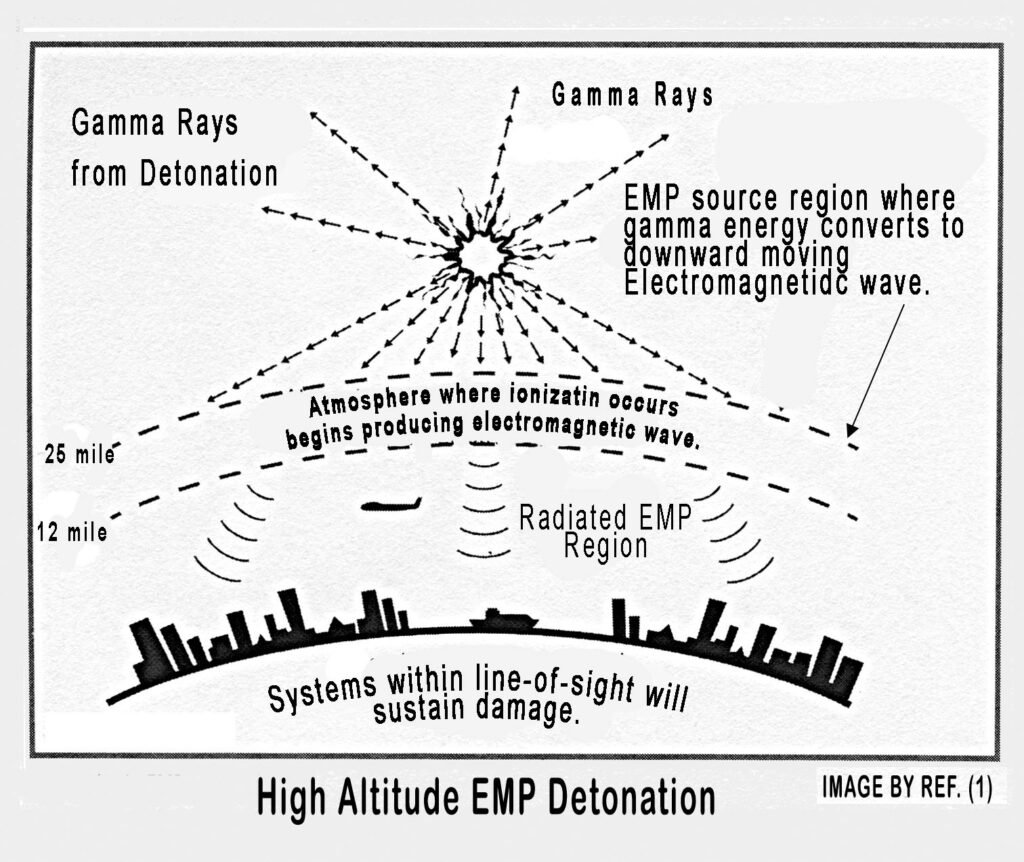An Electromagnetic Pulse (EMP) attack represents one of the most devastating yet underestimated threats facing modern civilization. A single high-altitude nuclear detonation could instantly cripple electronic infrastructure across entire continents, potentially triggering societal collapse within months. This comprehensive analysis explores the catastrophic potential of EMP weapons and why nations worldwide are racing to develop both offensive capabilities and defensive countermeasures.
- Understanding Electromagnetic Pulse (EMP): The Invisible Weapon
- The Physics Behind Nuclear EMP Weapons
- Critical Infrastructure Vulnerabilities
- Electrical Power Grid Susceptibility
- Communication Network Dependencies
- Military and Navigation System Impacts
- Nations with EMP Capabilities
- Historical EMP Incidents and Lessons Learned
- EMP Hardening and Protection Strategies
- The “Stone Age” Scenario: Societal Collapse Timeline
- Immediate Impact (Hours to Days)
- Short-Term Consequences (Weeks to Months)
- Long-Term Recovery Challenges (Years)
- Contemporary EMP Threat Assessment
- Mitigation Strategies and Future Preparedness
- Conclusion: Preparing for the Unthinkable
Understanding Electromagnetic Pulse (EMP): The Invisible Weapon
What is an Electromagnetic Pulse?
An Electromagnetic Pulse (EMP) is a brief but intense burst of electromagnetic energy that disrupts electronic systems across vast areas. This phenomenon, often classified as a “low probability, high consequence” event, poses minimal direct risk to human health but can instantaneously destroy the electronic infrastructure that underpins modern society.
EMP attacks work by inducing high-voltage current surges in electrical conductors, causing electronic devices and cables to behave as unintended antennas. This electromagnetic interference overwhelms internal systems with excessive current, leading to widespread disruption or permanent damage to critical infrastructure including power grids, communication networks, transportation systems, and financial services.
The Two Primary Sources of EMP
Natural EMPs originate from Geomagnetic Disturbances (GMDs), which occur when solar phenomena such as coronal mass ejections interact with Earth’s magnetosphere. These space weather events vary in severity based on solar activity cycles.
Man-made EMPs are intentionally generated through nuclear or non-nuclear weapons systems. High-Altitude Electromagnetic Pulse (HEMP) attacks involve detonating nuclear devices at extreme altitudes to maximize electromagnetic effects across continental areas, while Non-Nuclear EMP (NNEMP) devices provide more targeted disruption capabilities.
The Physics Behind Nuclear EMP Weapons
The Three-Phase EMP Phenomenon
When a nuclear device detonates at high altitude, it releases powerful gamma rays that interact with atmospheric molecules through the Compton effect, creating a complex electromagnetic cascade. The International Electrotechnical Commission defines nuclear EMP as comprising three distinct phases:
E1 Phase (Early-Time)
- Duration: Nanoseconds to microseconds
- Characteristics: Extremely high-intensity pulse across broad frequency bandwidth
- Primary Effects: Induces devastating voltages in electrical conductors, bypassing conventional surge protectors
- Most Critical Impact: Destroys sensitive electronics, communication systems, and control networks
E2 Phase (Intermediate-Time)
- Duration: Microseconds to seconds
- Characteristics: High-amplitude pulse similar to lightning strikes
- Primary Effects: Further damages systems already compromised by E1 phase
- Mitigation: Standard lightning protection provides some defense
E3 Phase (Late-Time)
- Duration: Seconds to minutes
- Characteristics: Slower, lower-amplitude waveform with persistent effects
- Primary Effects: Creates massive current surges in power lines and long conductors
- Critical Damage: Causes magnetic saturation and catastrophic transformer failures
EMP Coverage and Yield Factors
The geographical reach of an EMP attack depends on several critical factors:
- Nuclear yield of the weapon
- Detonation altitude (optimal range: 25-250 miles above Earth)
- Magnetic field variations based on geographical location
- Distance from the equator

Even a relatively small 1-kiloton nuclear device, when detonated at optimal altitude (approximately 25 miles), can affect areas with a radius of 440 miles, demonstrating the asymmetric threat potential of EMP weapons.
Critical Infrastructure Vulnerabilities
Electrical Power Grid Susceptibility
Modern power grids represent the most vulnerable target for EMP attacks. Several factors amplify this vulnerability:
Grid Expansion: Power systems have grown exponentially since the last major geomagnetic storm in 1921, with longer transmission lines acting as more effective conductors for induced currents.
Digital Control Systems: The transition from analog to digital Supervisory Control and Data Acquisition (SCADA) systems has introduced new electronic vulnerabilities while improving operational efficiency.
Transformer Vulnerability: Large transformers are particularly susceptible to E3-phase damage, with geomagnetically induced currents (GIC) causing core saturation, overheating, and permanent failure.
Communication Network Dependencies
Modern communication infrastructure faces multiple EMP vulnerabilities:
- Cellular networks rely on electronic switching systems
- Satellite communications are exposed to space-based EMP effects
- Internet infrastructure depends on electronic routing equipment
- Emergency services require functional communication networks
The interconnected nature of communication systems means that power grid failures cascade into comprehensive communication blackouts, severely hampering emergency response capabilities.
Military and Navigation System Impacts
Department of Defense (DoD) assets face comprehensive EMP vulnerabilities:
Command and Control Systems: C3/C4ISR networks could face complete disruption, paralyzing military coordination capabilities.
Weapon Systems: Advanced military platforms including fighter aircraft and naval vessels contain vulnerable electronic components.
GPS and Navigation: Satellite-based navigation systems face dual threats from direct EMP effects and high-radiation environments created by space-based nuclear detonations.
Nations with EMP Capabilities
Nuclear EMP Powers
Primary Threat Nations: Russia, China, North Korea, and Iran have explicitly incorporated EMP attacks into their military doctrines and possess the technical capabilities to execute HEMP attacks.
Super-EMP Weapons: Russia and China have reportedly developed enhanced nuclear devices specifically optimized for maximum EMP generation rather than explosive yield.
Delivery Methods: These nations possess various delivery mechanisms including:
- Hypersonic ballistic missiles
- Submarine-launched ballistic missiles
- Unconventional platforms (freighters, container ships)
Non-Nuclear EMP Capabilities
China’s HPM Dominance: Chinese organizations hold approximately 90% of global High-Powered Microwave (HPM) patents, indicating substantial investment in non-nuclear EMP technologies.
U.S. Development Programs: American military projects include:
- Counter-electronics High-powered Microwave Advanced Missile Project (CHAMP)
- Leonidas system integration for Counter-Unmanned Aerial System applications
Terrorist Organization Access: Reports suggest Iran supplies E-bombs to terrorist groups such as Hezbollah, representing a proliferation concern for non-state actors.
Historical EMP Incidents and Lessons Learned
Nuclear Test Demonstrations
Starfish Prime (1962): The 1.44-megaton space detonation caused electrical damage in Hawaii over 900 miles away, including:
- 300 streetlights disabled
- Numerous burglar alarms triggered
- Telephone microwave link damage
This test demonstrated that HEMP effects were far more extensive than originally calculated, with potential effects over the continental United States estimated at 22-30 kilovolts per meter.
Soviet EMP Test: A 1962 Kazakhstan test caused power line failures and electrical fires, confirming HEMP effects in real-world conditions.
Natural EMP Events
1989 Hydro-Québec Event: A geomagnetic storm caused complete power system collapse in 92 seconds, leaving 6 million customers without power and demonstrating cascading infrastructure failures.
Carrington Event (1859): The most severe recorded geomagnetic storm caused global telegraph system failures and widespread fires, illustrating the potential for natural EMP-like phenomena.
EMP Hardening and Protection Strategies
Multi-Layered Defense Approaches
Electromagnetic Shielding: Faraday cage technology using copper, aluminum, or steel provides 90-100 dB protection against E1 and E2 phases.
Surge Protection Systems: Specialized EMP/HEMP filters designed to handle high power levels and fast transients, unlike standard surge protectors.
Infrastructure Isolation: Complete shielding and elimination of electromagnetic penetrations provide the most assured protection.
Hardened Electronics: Redesigning vulnerable circuits to withstand higher current levels and electromagnetic interference.
Government and Industry Initiatives
U.S. Federal Response: The Department of Homeland Security, CISA, and FEMA have developed comprehensive EMP protection frameworks including:
- National Public Warning System with EMP-protected broadcast stations
- Joint Electromagnetic Pulse Resilience Strategy with five strategic goals
- Executive orders promoting cross-government EMP preparedness
International Hardening Efforts: Nations including Taiwan have implemented military-standard electromagnetic hardening (MIL-STD-188-125-1) for critical infrastructure protection.
The “Stone Age” Scenario: Societal Collapse Timeline
Immediate Impact (Hours to Days)
- Healthcare Crisis: Hospital patients on life support face immediate mortality risk
- Transportation Paralysis: Electronic vehicle systems fail, causing accidents and gridlock
- Communication Blackout: Emergency services lose coordination capabilities
- Financial System Collapse: Electronic banking and payment systems cease functioning
Short-Term Consequences (Weeks to Months)
- Food Distribution Breakdown: Refrigeration, processing, and transportation systems fail
- Water System Failures: Pumping stations and treatment facilities lose power
- Supply Chain Collapse: Just-in-time delivery systems face complete disruption
- Public Health Crisis: Sanitation systems fail, leading to disease outbreaks
Long-Term Recovery Challenges (Years)
- Infrastructure Replacement: Large transformers and critical components require years to manufacture and install
- Economic Devastation: GDP losses potentially reaching trillions of dollars
- Social Instability: Prolonged outages lead to civil unrest and governance breakdown
- International Implications: Global economic and political disruption
Contemporary EMP Threat Assessment
Asymmetric Warfare Advantages
EMP weapons provide significant strategic advantages to adversaries:
Non-Kinetic Destruction: Massive infrastructure damage without immediate human casualties, potentially avoiding full military retaliation.
Attribution Challenges: Attacks from unconventional platforms can obscure source identification, complicating response strategies.
Force Multiplication: Relatively modest nuclear yields can achieve continental-scale effects, providing asymmetric capabilities to smaller nuclear powers.
Current Vulnerability Levels
Modern societies face unprecedented EMP vulnerability due to:
- Digital Dependencies: Increased reliance on electronic systems for all critical functions
- Infrastructure Interdependencies: Cascade failures across multiple sectors
- Limited Hardening: Most civilian infrastructure lacks EMP protection
- Recovery Challenges: Complex supply chains and specialized components complicate rapid restoration
Mitigation Strategies and Future Preparedness
Individual and Community Preparedness
Emergency Planning: Developing communication and coordination plans for extended power outages.
Resource Stockpiling: Maintaining supplies of food, water, medicine, and essential equipment.
Alternative Technologies: Investing in EMP-resistant communication and power generation systems.
National Security Priorities
Critical Infrastructure Protection: Prioritizing EMP hardening for essential services including hospitals, emergency services, and communication networks.
Military Readiness: Ensuring continuity of command and control capabilities during EMP events.
International Cooperation: Sharing best practices and coordinating response strategies with allied nations.
Conclusion: Preparing for the Unthinkable
The potential for a single EMP blast to send an entire nation back to the Stone Age represents more than hyperbolic fear-mongering—it constitutes a scientifically grounded assessment of modern society’s fundamental vulnerability. The interconnected nature of critical infrastructure, combined with widespread dependence on electronic systems, creates conditions where electromagnetic warfare could achieve strategic objectives previously requiring massive conventional or nuclear attacks.
The distinct characteristics of the E1, E2, and E3 phases present complex challenges requiring specialized mitigation approaches. While complete protection remains technically and economically challenging, strategic hardening of critical infrastructure combined with comprehensive emergency preparedness can significantly reduce societal vulnerability.
As nations continue developing both offensive EMP capabilities and defensive countermeasures, the electromagnetic domain represents an increasingly critical aspect of national security. The race between EMP weapon development and infrastructure hardening will likely determine whether future conflicts escalate to electromagnetic warfare or whether effective deterrence can be maintained through defensive preparedness.
The Stone Age scenario remains a stark reminder that technological advancement, while providing tremendous benefits, also creates new vulnerabilities that require proactive attention and sustained investment in resilience measures. Only through comprehensive understanding of EMP threats and systematic implementation of protection strategies can modern nations maintain their technological advantages while defending against electromagnetic warfare.




